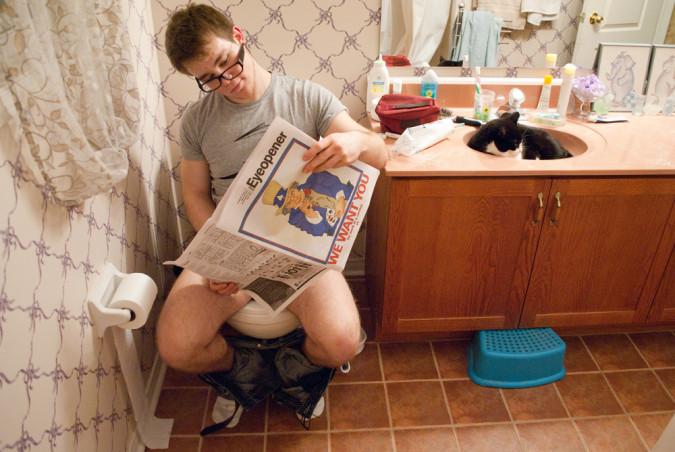You can pretend it doesn’t happen, but we all do it. Victoria Stunt looks into the mysteries of Number Two
You’re sitting at the dinner table and your stomach is cramping – you feel like you’re about to explode.
“Excuse me,” you say.
This is the third time you’ve left the table. You have to shit again.
How embarrassing.
But wait, what’s so bad about shit? Anish Sheth studies it. He’s a gastroenterologist, and compares it to a snowflake.
“Each bowel movement has a uniqueness that should be regarded with wondrous appreciation. Too often dismissed as useless and malodorous waste, poo has struggled since the dawn of time to receive the respect is deserves,” says the prelude of the book he co-authored, What’s Your Poo Telling You?
It sounds silly, but giving your fecal matter the respect it deserves may be more important than you think.
Some say feces are the number one indicator of a person’s good or bad health, and that we should take a look in the toilet bowl more often.
“It’s one of a few things you can do without a doctor’s help. You can’t do blood work on yourself… but you can look in the toilet,” Sheth told the Daily Mail.
Lori Ryan is a nutritionist from St. Catharines, Ont. She says she uses poop to search, find and discover what’s going on in the entire body.
It gets all of the carbohydrates, fats, proteins, nutrients, sodium and potassium to all the other parts of the body, she says.
Once in the toilet bowl, your stool may indicate diseases like diabetes, colitis, Crohn’s disease, hepatitis, liver issues, gallbladder problems and even cancer.
If your stool has blood in it, you could have Chron’s disease, an inflammation of the bowels. If it’s a white-ish colour, it could mean you have hepatitis or liver disease.
Sometimes prolonged diarrhea is a sign of cancer. The list goes on.
If you feel it’s out of the ordinary, Ryan says you should go see a doctor or nutritionist right away.
But some people struggle to share what’s going on with their bowel movements with even their doctor.
“They think it’s something to avoid speaking about,” she says.
Ryan once had a 25-year-old patient who had bloody stool for more than a week before he went to her.
“Now why did that young man not go on the first day?” she says. “It’s unfortunate, but… he was embarrassed.”
She diagnosed him with colitis, an inflammation of the inner lining of the colon.
She says if he had seen her sooner, his recovery would have been much easier.
“I believe it’s something that we’re just culturally taught not to discuss. We just… don’t have any interest in sharing with another person and making it common knowledge that we’re not feeling well,” Ryan says. “We’re ashamed, actually.”
France’s King Louis XIV would apparently hold official meetings while sitting on the toilet. Although we’re at that point – and maybe don’t really want to be – the taboo around poo is letting up a little.
Twitter users are encouraged to tweet while on the toilet with #tweetfromtheseat. Television personality Dr. Oz regularly devotes his shows to educating about feces.
There are even apps to keep track of bowel movements, like Poo Log.
The app helps record the details of your poo: what the delivery was like, how big it was, the number of particles, how it smelled, the number of times you wiped, and your “postpoo sentiment.” It also lets you time your poops, and graph them.
Recording your bowel movements on apps like Poo Log can help you realize whether you’re constipated, or have had loose stools for far too long.
When your bowel movements aren’t regular, Ryan says to avoid using products from the drug store to help fix constipation or diarrhea.
Instead, she recommends natural remedies.
She uses the acronym BRAT: bananas, rice, apple sauce and toast.
Eating these foods will help to bind someone up and get rid of diarrhea.
If constipation is the issue, she recommends drinking baking soda and water, herbal tea, or water with sea salt every hour. They all help to move fecal matter from the body naturally.
Gastroenterologists at the University of Bristol in England developed a chart called the Bristol Stool Chart, that classifies stool into seven types.
“A good shape would have the shape of the intestine, which kind of looks like a balloon effect,” Ryan says. “If they haven’t got any indentations, and it’s just very smooth on the outside that’s unhealthy because that means you’re leaving pockets behind of fecal matter.”
She says the perfect bowel movement is one that is light to medium brown in colour. If it’s green, you have eaten a lot of green vegetables.
If it’s red (and it’s not blood) you have eaten beets.
Ryan says there’s a proper way to pass your stool, too.
Putting your feet up on a stool can help for an easier delivery. Sitting on the toilet for a long time puts strain on the rectal muscles, which can cause hemorrhoids.
“You just spend enough time to eliminate,” she says. It shouldn’t take more than a minute or two.
“Once the bowel movement has been completed, don’t sit there and read. It’s not a place for sitting and reading,” she says.
Jokes aside, what you plop into the toilet bowl is serious stuff. So get your feet up, open that app, start tweeting and poop away.










Leave a Reply